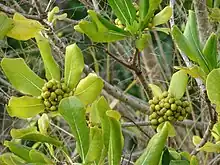Pittosporum viridiflorum
Pittosporum viridiflorum (Cape cheesewood,[1] Afrikaans: Kasuur, Sotho: Kgalagangwe, Xhosa: Umkhwenkwe, Zulu: Umfusamvu) is a protected tree in South Africa.[2]
| Pittosporum viridiflorum | |
|---|---|
 | |
| Scientific classification | |
| Kingdom: | Plantae |
| Clade: | Tracheophytes |
| Clade: | Angiosperms |
| Clade: | Eudicots |
| Clade: | Asterids |
| Order: | Apiales |
| Family: | Pittosporaceae |
| Genus: | Pittosporum |
| Species: | P. viridiflorum |
| Binomial name | |
| Pittosporum viridiflorum Sims | |
Morphology
The leaves are obovate with margin entire and wavy, conspicuous net veining, crowded at ends of branches. Often with a single mis-formed leaf. The midrib has a yellow colour and the leaf has a brilliant green colour when viewed against the light. Fruit borne in clusters at the end of branches, yellow becoming brown, dehiscent with four bright red seeds covered with a sticky exudate with a faintly sweet smell. The bark has brown lenticels.
Distribution
Pittosporum viridiflorum ranges across Sub-Saharan Africa, mainly in the east from Ethiopia to South Africa and occasionally to the west. It is also found in Yemen and India.[3]
Habitat
Pittosporum viridiflorum is found in drier forest and evergreen bushland, rain forest, farmland derived from these vegetation types, bamboo forests, degraded Juniperus procera forest, riverine and swamp forest, humid woodland, and sometimes on rocky outcrops. It ranges from 650 to 2,600 meters elevation.[3]
References
- USDA, NRCS (n.d.). "Pittosporum viridiflorum". The PLANTS Database (plants.usda.gov). Greensboro, North Carolina: National Plant Data Team. Retrieved 6 October 2015.
- "Protected Trees" (PDF). Department of Water Affairs and Forestry, Republic of South Africa. 3 May 2013. Archived from the original (PDF) on 5 July 2010.
- Tropical Plants Database, Ken Fern. tropical.theferns.info. 2021-08-06. <tropical.theferns.info/viewtropical.php?id=Pittosporum+viridiflorum>
External links